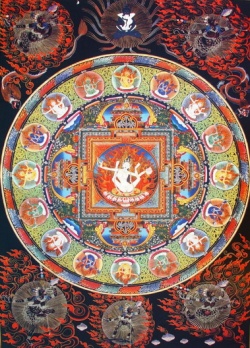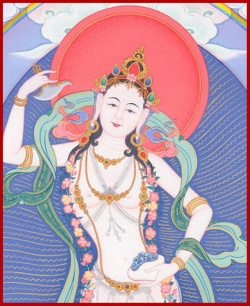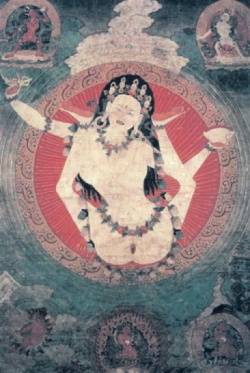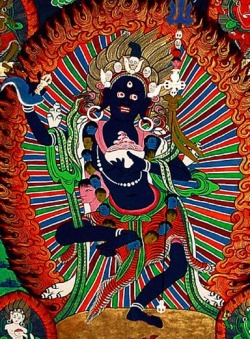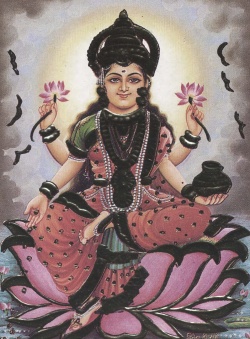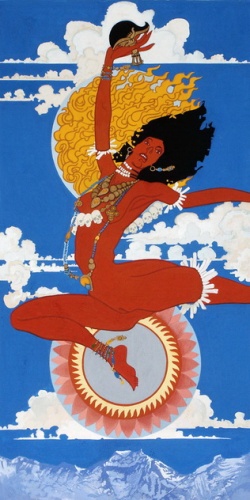Dakini visualized in the Chod rite
In the last two chapters we have met the guru and the yidam, the esoteric versions of the Buddha and Dharma Refuges. Now it is time to meet the dakini, the third esoteric Refuge, the hidden jewel - the hidden ruby, we could say - of the Sangha. Personally, I think it is impossible to produce an adequate definition of a dakini. To attempt to catch a dakini in the iron trap of mundane logic is a hopeless task. In one Sanskrit dictionary the word dakini is said to refer to a class of flesh-eating demoness.
The Tibetan translation, khandroma, means female sky-goer. Sometimes she is referred to as a sky-dancer. The male counterparts, dakas, do exist, but they play a relatively insignificant role in the Tantra, whereas dakinis are central to it.57 Rather than define the dakini, let us try to see the situations in which she appears. We have seen that she is the esoteric Sangha Refuge, so we can expect her to be related to the guru in the same way that the Sangha is related to the Buddha.
The Sangha is the community of all those who are learning from the Buddha how to follow the path to Enlightenment. The Sangha gathers round the Buddha as often as possible - to learn from him and for the sheer pleasure of being with him. On the esoteric level, then, we should expect to find dakinis clustering around the vajraguru. This is indeed the case. If you find the vajraguru, the dakinis will not be far away. However, the Tantric guru - the 'thunderbolt guru' who will stop at nothing to show you Reality - is often difficult to find. For example, Naropa spent a very long time searching for Tilopa. When you do find the guru he will often be in a strange or frightening place: on an island in the middle of a poisonous lake like Kukkuripa (one of Marpa's gurus), in the depths of the jungle like Naropa, or most frequently in a cremation ground.
It is in places like these that you find the vajraguru, and so it is in these fearsome places that you will meet the dakinis. Padmasambhava, for example, spent many years meditating in cremation grounds (that had names like Piled-Up Corpses, and Sleep in the Mysterious Paths of Beatitude). In each one he feasted and danced with the dakinis, and taught them the Dharma. So to meet a dakini is not easy. They are not domesticated but wild. To find them you have to leave behind the security of your views and ideas.
You have to abandon the tidy civilized world of mundane concepts. You have to walk out into the unknown, the unexplored, the unimaginable. A Tibetan yogin named Khyungpo Naljor visited India many times, searching for a highly-realized teacher who could show him the way to full Enlightenment. All the teachers he met told him that he should try to meet the yogini Niguma, who had been the disciple and Tantric consort of Naropa. On simply hearing the name of Niguma, Khyungpo Naljor was filled with great happiness, and he set off to find her. He had been told that she had gone beyond any dependence on the physical body, but that she sometimes appeared in a certain cemetery.
When he arrived in the cemetery, the yogin fearlessly sat himself down in the midst of the corpses and the wild animals that dwelt there. As a result, he had a vision of a brown dakini. She was completely naked, except for a few ornaments, all made of human bone. She had a khatvanga and carried a skull cup. She was dancing ecstatically in the sky high above his head. At times she multiplied herself into many wild dancing figures, filling the sky, at others there was just one great figure in the air above him. Khyungpo Naljor realized he must be in the presence of Niguma, and asked for instruction.
But the dakini said that she was an ogress, and when her helpers arrived they would feast on his blood; he had better escape while he still had his skin. Kyungpo Naljor ignored this threat, and continued asking for teaching. Seeing that he could not be scared away, the dakini changed tack. She asked him for a large amount of gold for her teaching. (In Tantra it is usual to give something of value for initiation, to demonstrate one's seriousness, and out of gratitude for the immense spiritual riches to which the empowerment gives access.) Kyungpo Naljor had saved up a great deal of gold with which to seek teachings in India. Very reverently he offered it all to the dakini.
Without a moment's hesitation she threw it away into the jungle. If there had been any doubt in the yogin's mind before, it was wiped away by this evidence of the dakini's complete non-attachment, even to tremendous wealth. He knew that he was dealing with an Enlightened teacher. The dakini then proceeded to give him initiation, much of it in dreams. In this story we see how the dakini can appear. She irrupts out of another realm. It can happen anywhere, at any time, but she reveals herself most truly when she dances free in the sky of Emptiness. There is nothing fixed about her, though. She is quite capable of shifting shape. She may manifest as a beautiful young maiden or goddess, or as a decrepit old crone. The dakini Vajrayogini appeared to Naropa as a hag with thirtyseven ugly features.
(After she had convinced Naropa to seek Tilopa, and then vanished like a rainbow, Naropa sang a song giving thirty-seven similes for the dangerous and unsatisfactory nature of samsara.) The dakini may appear as voluptuous and alluring, or as threatening. (Niguma first warned Kyungpo Naljor that she was a flesh-eating demoness.) Some dakinis are part animal. They may have the heads of boars, tigers, crows, bears, jackals, or a host of other strange creatures. Their bodies can be any of, or all of, the colours of the rainbow. Most usually, however, the dakini appears as a naked, dishevelled, dancing, witch-like woman. Her element is the sky, and it is there that she dances. Let us look more closely at one of the most important of all dakinis. This is Vajrayogini (Tibetan Dorje Naljorma), who to Naropa appeared withered and wrinkled (perhaps because he had lost himself in scholarship, so the upsurging forces of inspiration, which dakinis embody, had become dull and neglected.)
More commonly, Vajrayogini appears as a sixteenyear- old girl, an age considered by Indians to be the prime of youth. She is a virgin, symbol of her complete innocence in relation to samsara. Her body is a brilliant, fascinating red - the colour of arousal and passion, for Vajrayogini is fiercely in love with the Dharma. She has flowing dishevelled black hair, for she has gone beyond concern for worldly appearances. She dances, abandoning herself to the inspiration of the Dharma. In her right hand she brandishes a vajra-chopper above her head. This is a brutal implement, used by butchers for cutting and flaying. It has a vajra handle, and its blade is razor-sharp. With her chopper the dakini cuts off all attachment, especially concern for the physical body. For the fainthearted, the brandished vajra-chopper is a threat of destruction.
For the brave it is an invitation to approach and be cut free of all limitations. In her left hand she clasps to her heart the skull cup of Sunyata, filled with the ambrosia of Great Bliss, for it is this mahasukha which the dakini pours out like wine to her devotees. On her head is a tiara, for she is spiritually rich. However, rather than jewels, it is set with five human skulls. These are reminders of the Wisdoms of the five Buddhas in a form that cannot be ignored. Around her neck hangs a garland, not of flowers but of human heads, freshly-severed and dripping with blood. There are fifty of them.
These correspond to the sixteen vowels and thirty-four consonants of the Sanskrit alphabet, known as ali and kali. As her ornaments they symbolize that the dakini has purified speech on the subtlest level. The circle of heads also suggests the endless round of birth and death. The dakini thrusts herself beyond it, and life and death become her ornaments. Thus she wears armlets, wristlets, and anklets of human bone. In the centre of her chest, secured by strings of bone, is a mirror in which all beings can see the effects of their past actions. These adornments are the dakini equivalents of silks and jewels - symbolizing the six Perfections of the Bodhisattva. While dakinis are beautiful and can appear in wondrous raiment, it is as though they are too close to the realities of existence to cover themselves in pretty, alluring things.
They are the Truth, and you can take them or leave them, they are not going to try to entice you. It is as though the Bodhisattvas such as Avalokitesvara and Tara are the Dharma experienced in the warmth of the heart. Dakinis are the Dharma felt in one's guts. In the crook of her left arm Vajrayogini holds a magic staff, similar to Padmasambhava's. This symbolizes her mystic consort. Though she appears in female form, the dakini is not lacking in masculine qualities. She is the perfect synthesis - feminine and masculine dancing together. The masculine is present, but more hidden and inward. She dances with her right foot raised, so that her legs form a rough bow and arrow shape.
The supporting left leg is the bow, the upraised right the arrow. The bow and arrow are important symbols in Tantra, symbolizing the inseparability of wisdom and method. With her left foot she is trampling on a prostrate human figure - symbol of the craving, hatred, and ignorance that she has subdued, and which she now victoriously stamps into the ground. Yet she is not concerned with what is happening under her feet. Her mastery of samsara is so total that she flattens obstacles effortlessly, like a small boy treading on an ant. The whole movement of her being is upwards. Her hair stands on end. She leaps as she dances, as though impatient to take off into a higher dimension. In the centre of her forehead is a third eye, for she is able to see a higher truth, a wisdom beyond duality. All around her body, flames leap upwards.
These are the fires of her soaring inspiration, her unquenchable energy, her purifying wisdom. They are fires of love burning for all that lives. Her expression is ecstatic. She is drunk with wisdom, entranced with spiritual power, wild with compassion, insatiable for truth. At the same time her look is dangerous, warning. Like all dakinis, she doesn't fool around. The more frequently visualized dakinis The Tantra recognizes three orders of dakini, the lowest of which have not emancipated themselves from samsara and may be either helpful or hostile to human beings.
The middle order is associated with twentyfour sacred places to be found in India and Tibet, and can only be perceived by those who are spiritually developed. These twenty-four sites are also related to aspects of the subtle body, and in some forms of advanced Tantric practice dakinis of this order are visualized within one's body. The highest order is known as 'spontaneously Enlightened' and consists of emanations of the dharmakaya. Most of the dakinis we shall look at in this section belong to this highest order, being embodiments of full Enlightenment. We have already met Vajrayogini in one of her principal manifestations.
She can be red or white, though red is more common. As we shall see, though dakinis can be of any colour they are frequently red, as they are associated with passion and intensity in the quest for Enlightenment, and the fiery upsurging forces of spiritual inspiration. Vajrayogini is visualized in many different forms of Tantric practice. For instance, in a Nyingma sadhana of Guru Yoga one transforms oneself into Vajrayogini. Above one's head is one's own teacher, and above him, one above another in the sky, is the lineage of gurus, going back through time to its Enlightened source. One becomes Vajrayogini in this practice to emphasize receptivity to the gurus of the lineage, and perhaps to attract their blessings magically, by appearing in the most fascinating form possible.
Vajrayogini is also a central figure in the tummo or 'heat yoga', which is the first of the 'six doctrines' of Naropa and Niguma. This advanced practice is capable of increasing bodily warmth, rendering one impervious to cold. Though much is made of this by some Western writers, it is really only a side-effect. The main purpose of the practice is to produce an extraordinary concentration of psychophysical energy. This is done by inducing the subtle energies of the body to become unified by entering the central channel of the subtle energy pathways within the body. Inducing these energies to enter the central channel produces a very strong experience of blissfulness. As we saw in Chapter One, combining this blissful experience with contemplation of Sunyata is an extremely effective way of gaining full realization.
Vajrayogini is visualized in the tummo yoga, as she symbolizes particularly the union of Emptiness and Great Bliss. Her red colour also suggests the blazing fire of tummo. Another appearance of Vajrayogini occurs in the Chod Rite, which we shall examine briefly when we meet Machik Labdron. In general, Vajrayogini appears in many Tantric practices, as well as having a number of sadhanas of Highest Tantra devoted purely to her. Vajrayogini appears in several forms other than her dancing one. For instance, she can have the same colours, implements, and so on, but be stepping to the left, with her right leg outstretched. In this form, she is also known as Sarvabuddhadakini (dakini of all the Buddhas), for she is that huge wave of passionate commitment to Truth and Freedom which has carried all the Buddhas to Enlightenment.
In Tibetan, this form is known as Naro Khacho - the dakini of Naropa. Her practice is one of the thirteen 'golden dharmas' of the Sakya school of Tibetan Buddhism. This time both her feet stamp on samsaric figures. In this position she no longer waves the chopper aloft; it is held loosely by her right side, as though it has done its work. Here she perhaps emphasizes the stage of the path beyond that at which one needs to cut down the promptings of samsara. If you have to cut them down, you are still involved with them, still using energy in fighting them. Beyond this you reach a relaxed state in which the mind can be left alone.
Your understanding of Reality is such that thoughts and emotions can be allowed to form themselves and dissolve away, like bubbles on a stream. If her right hand has relaxed, her left now comes fully into play. The skull cup is no longer held to her heart but aloft, above her head, which is tilted back, as she quaffs a flow of the red light-nectar of Great Bliss, which looks just like blood. Blood is life, and the dakini drinks incessantly, becoming filled with spiritual zest and energy. Her large breasts are thrust forward, symbolizing her capacity to bestow Great Bliss on all beings. Another almost identical form of this dakini, which is of particular importance for the Kagyu school of Tibetan Buddhism, is Vajravarahi (Tibetan Dorje Phamo). She can only be distinguished from the dancing form of Vajrayogini by one characteristic.
In her piled-up hair appears the head of a sow. Vajravarahi means diamond sow. The pig or sow is a Buddhist symbol for ignorance. It appears at the centre of the bhavacakra, or Wheel of Life, in a kind of dance with the snake of hatred and the cock of craving. The three career round in a circle, each one biting the tail of the one in front. The sow in Vajravarahi's hair is like a trophy. She has severed the head of the sow of ignorance with her vajra-chopper, and brought the drunken dance of samsara to an end.
